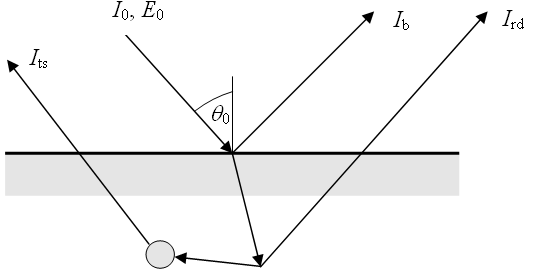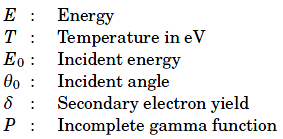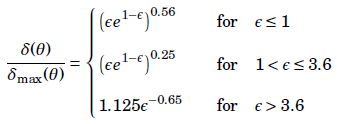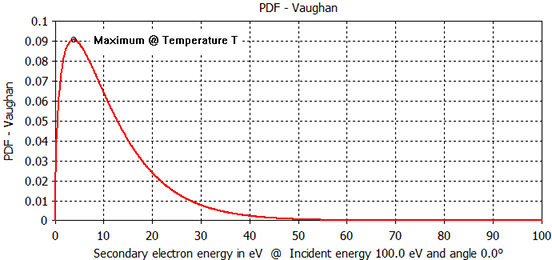

Introduction to Secondary Emission
Backscattered or elastic reflected electrons
General model assumptions/definitions
In general, secondary electrons can be generated in three different ways:
Backscattered electrons. An incident electron undergoes an elastic collision at the surface of a material and it is reflected back.
Rediffused electrons. An incident electron moves into a material, but it is scattered back out of the material.
True electrons. An incident electron moves into a material and due to collisions, electrons other than the incident one are scattered out of the material.

The Import and the Vaughan [0] emission model consider only true secondary electrons whereas the Furman [1] emission model considers all three types of secondary electrons mentioned above. Thus the Furman emission model is usually the most accurate emission model, but a lot of parameters must be defined to set up the emission model properly. In many cases the Vaughan or Import emission model is sufficient.
The secondary yield is defined by the ratio of the emitted current over the incident current and can be greater than one without violating the law of energy conservation.

[0] Vaughan: Secondary Emission Formulas.
[1] Furman. Probabilistic model for the simulation of secondary electron emission.
Furman: Backscattered or elastic reflected electrons
The probability distribution function (PDF) for the backscattered electrons can be written as follows:

The secondary emission coefficient, which is depended of the incident energy and angle, can be described by:


The probability distribution function (PDF) for the rediffused electrons can be written as follows:

Here, the secondary emission coefficient, which is depended of the incident energy and angle, can be described by:


Furman: True secondary electrons
The probability distribution function (PDF) for the true secondary electrons can be written as follows:


In the above expression, P is the normalized incomplete gamma function. The secondary emission coefficient, which depends on the incident energy and angle, can be described by:



The parameters pn are depend on the material selected via the material dialog tab and they can not be changed by the user.
To avoid the problem that some probabilities can become negative, a modified secondary electron yield is defined:

The probability for the true secondary electrons is a binomial distribution, where M is the maximum number of secondary electrons per incident electron:

Furman: General model assumptions/definitions
In order to calculate the number of secondary electrons, the probabilities are defined and calculated using the following relationships:



The azimuthal scattering angle is uniformly distributed, whereas the probability distribution function for the polar angle is given by:

Material Parameters: default - SEE Vaughan
The Vaughan emission model is a heuristic emission model. The secondary electron yield is defined by three parameters: the threshold energy, the maximum yield and the energy at the maximum yield.

The incident angle theta is included in the model via modifications of the maximum yield and energy according to the following expressions:
|
|
and |
|

The parameter ks is a so-called smoothness parameter and depends on the surface of the material. Typically this parameter is set to unity.
To calculate the yield,a normalized incident energy is used, which is defined as follows:

For oblique incident angles, the normalized energy is reduced. Then the following relations hold for the secondary yield as a function of the normalized energy:

The energy of the secondary particles is gamma distributed. The temperature T is defined by the user. The temperature T is defined in units of energy, eV.


Material Parameters: default - SEE Import
The secondary electron yield for normal incident (theta = 0) is imported by the user. Thus arbitrary shapes of the SEY curve can be used. The dependency of the incident angle is included via the following relations:


The model is intended to be as simple as possible, thus no surface smoothness is considered. The threshold energy is automatically detected by the import. If the threshold energy is zero, the angular dependency is identical to the dependency in the Vaughan emission model.
The energy of the secondary particles is follows a gamma distribution. The temperature T can be defined by the user. The temperature T is defined in units of energy, eV.



The generation of random numbers for the secondary electron emission is based on a deterministic algorithm, that means calculations are reproducible. If a nondeterministic random number generation process is required, that can be enabled via VBA methods, as shown below for the PIC and tracking solvers. It is noted that two calculations with the same settings and nondeterministic SEE yield different results.
PIC Solver
With PICSolver
.SEEDeterministicRandom "False"
End With
TrackingSolver
With TrackingSolver
.SEEDeterministicRandom "False"
End With
Secondary Electron Emission Overview
Material Parameters: default - Secondary Electron Emission
Material Parameters: default - SEE Import
Material Parameters: default - SEE Vaughan
Material Parameters: default - SEE Furman True
Material Parameters: default - SEE Furman Elastic
Material Parameters: default - SEE Furman Rediffused